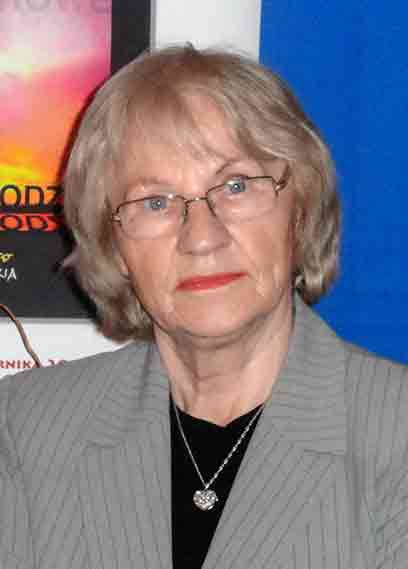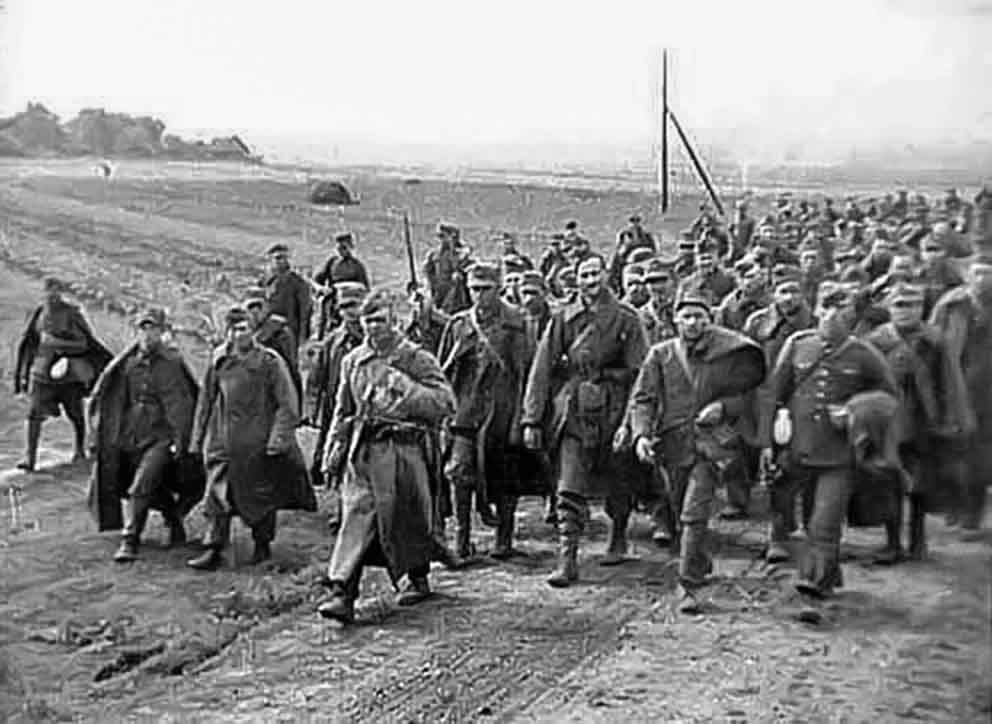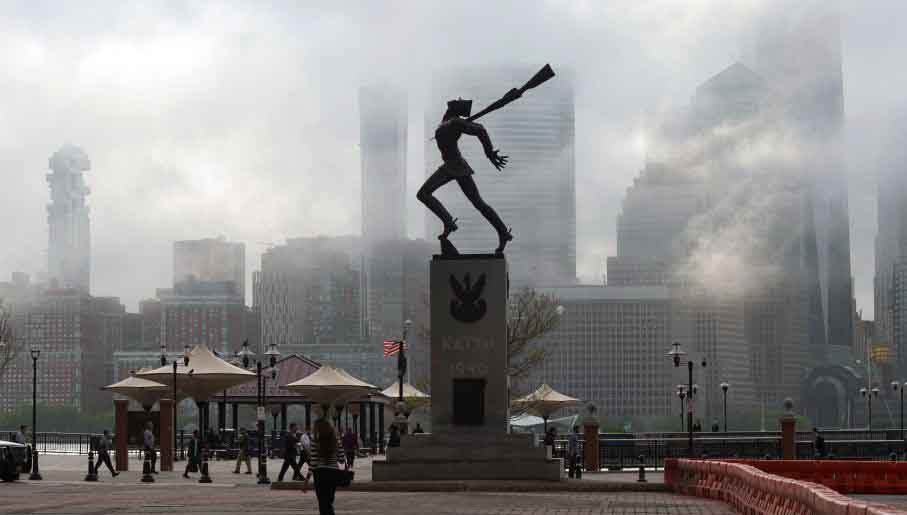The Katyn Massacre was one of the most barbaric international crimes in the history of the world. (Madden Report)
Introduction to the Events
1939 was one of the most tragic years in Poland's history, beyond comparison to any other event. On September 1st, Germany invaded Poland. On September 17th, under the secret Ribbentrop-Molotov Pact, the Red Army started a "liberation march to the territories of Western Ukraine and Western Belarus". Without declaring war, it attacked the eastern territories of Poland. Confused by the "general directive" issued on September 17 by Marshal Edward Rydz-Smigły in Kołomyja, in which he ordered "not to fight the Bolsheviks...", Polish troops, often without a fight, were deceptively disarmed, taken prisoner and transported to prisoner-of-war camps. In this way, about 250,000 Polish soldiers (including 18,000 officers) who found themselves on the eastern side of the demarcation line established by the secret protocol between Germany and USSR were taken prisoner, and thus the 4th partition of Poland was done.
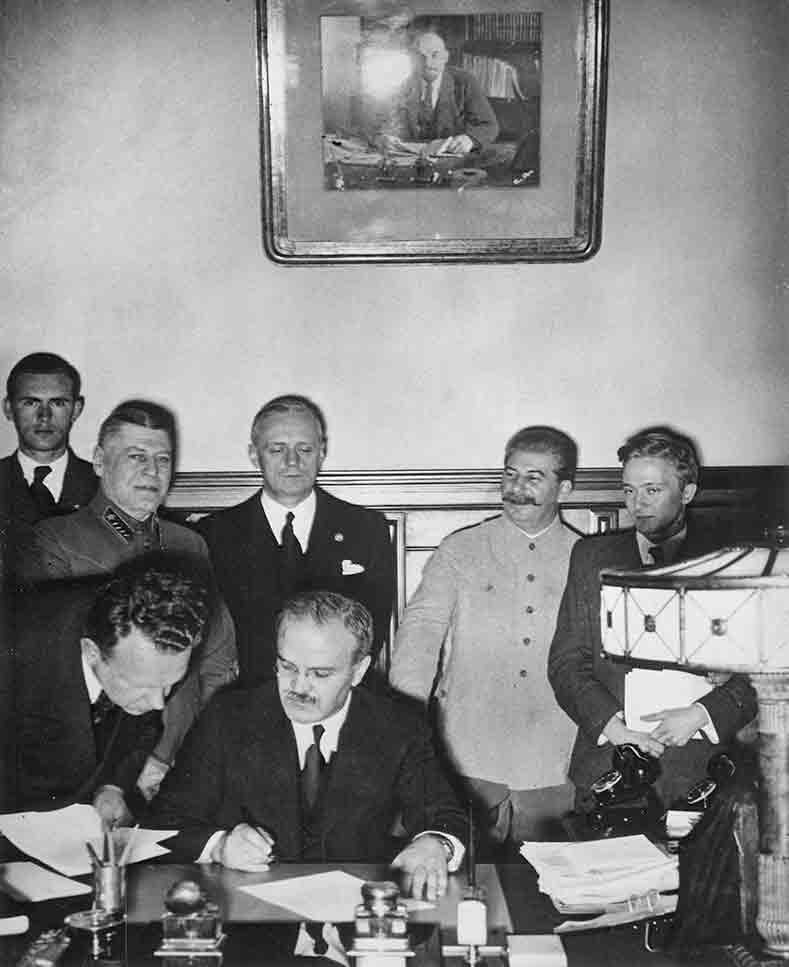
The Soviet Minister of Foreign Affairs Vyacheslav Molotov is signing the pact with Germany in 1939. In the background, his equivalent in the 3rd Reich Ribbentrop, and smiling Stalin.
The Red Army units were followed by special units of the NKVD, to which on September 19, the People's Commissar for Internal Affairs, Lavrenty Beria, issued a special order No. 0308 specifying their tasks concerning Polish prisoners of war. These units, according to previously prepared proscription lists, carried out immediate arrests (or executions) of local elites. Officers of the State Police, Border Protection Corps, prison services, foresters and other uniformed services, as well as military settlers, landowners, factory owners and officials were arrested. This was to break up the structures of the administration of the Republic of Poland and organize in their place new organs of Soviet power in the form of temporary committees.
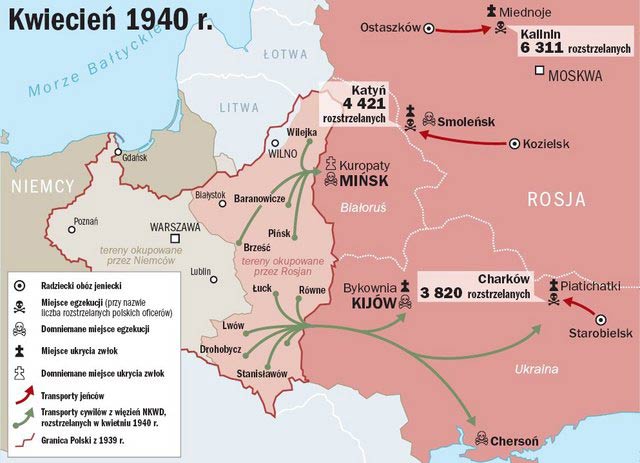
The map of the Katyn Massacre "April 1940". (Source: Wikipedia)
In makeshift prisoner-of-war camps, selections were made and people were transferred to special-purpose camps. Officers were separated from non-commissioned officers and privates, who were sent to forced labor in gulags, handed over to the German side, or released. A group ready (or presumed ready) to cooperate with the Soviets was also selected and subjected to intensive "training". After intensive interrogations and arrests in the camps, most of the officers of the Polish Army and policemen imprisoned in the USSR (about 15,000) were concentrated in three special camps: Kozelsk, Starobelsk and Ostashkov. All three camps were located in the premises of former Orthodox monasteries, which were turned into NKVD prisons. They functioned from September 1939 to May 12, 1940.
In Kozielsk (about 250 km from Smolensk), the camp was located on the monastery premises of the former Orthodox Optyń Hermitage. Officers and cadets of active service and reserves of the Polish Army were concentrated there. From this camp, 4,410 victims were murdered and buried in mass graves in the Katyn forest.
In Ostaszków (about 11 km from Ostaszków, near the village of Kalinin - the former Tver), the camp was also located in the former monastery buildings of the Niłowo-Stołobieńska Hermitage. The officers of the Police, Border Guard Corps, Border Guard, prison service and intelligence officers were held there. The list of those murdered from this camp includes 6,314 people.
In Starobelsk (on the Ajdar River) there was the first special officers' camp located in the former monastery buildings of the Protection of the Mother of God. 3,739 people were murdered from this camp.
The Katyn massacre
The Katyn massacre, according to many legal definitions, is classified as a crime against humanity, a crime against peace, a communist crime, and a crime of genocide. For the sake of political correctness, different terms were used at various times in history. Why is the case of the Katyn massacre so difficult, and why it has so long remained silent and is still not fully clarified? Perhaps recalling some of the most painful facts will bring you closer to understanding the problem.

Top secret note 794/b of the Politburio dated 2 march 1940 - "...Each of them only looks for liberation so that they can actively join the fight against the Soviet power..."
On March 2, 1940, the head of the NKVD, Lavrenty Beria, sent a secret note no. 794/b to Joseph Stalin, in which he stated that Polish prisoners of war (14,736 people - including 97% Poles) and prisoners in western Belarus and western Ukraine (18,632 people, including 1,207 officers and 5,141 policemen - a total of 57% of Poles) are declared enemies of the Soviet government and do not bode well for improvement. In this memo, Beria considered it justified to shoot 14,700 prisoners-of-war, and 11,000 prisoners, without summoning the convicts, without charging them, without a decision to terminate the investigation, or an indictment.

"Top Secret" decision of the Central Committee's Politburo dated 5 March 1940 (from the archives of the Katyn Museum in Warsaw)
On March 5, 1940, the Political Bureau of the Central Committee of the VKPB (All-Union Communist Party (Bolsheviks), orig. Всесоюзная коммунистическая партия большевиков; ВКПБ, i.e. VKPB - ed.) issued a secret decision No. P13/144 approving Beria's suggestions. Stalin, Voroshilov, Molotov and Nikoyan (the most important decision-makers in the Politburo) signed the decision. Notes on the note were made by Secretary Kalinin.
On March 22, 1940, Beria issued a secret order No. 00350 "on the unloading of NKVD prisons in the Ukrainian and Belarusian Soviet Republics." Shipments ("unloading the camps") of convicts were organized on the basis of disposition lists sent from Moscow. These lists (with a few exceptions) were death sentences. On their basis, convoys were created to reach the places of execution on foot, in cars, by rail, or in prison ambulances. There were several places of execution and burials. To this day, it is anybody's guess how many mass graves are still undiscovered.
On April 3, 1940, the first transport of prisoners sent for execution to Katyn left the Kozelsk camp. Officers held in Kozielsk were transported by train to the Gniezdowo station, and then by prison ambulances to the crime scene - Kozia Góra (Goat Mountain), in the forest near Katyn. There, previously excavated pits were waiting, over which the convicts were placed and murdered at close range with a shot in the back of the head, and then the bodies were pushed into the pits. Younger and stronger prisoners had coats over their heads and their hands tied behind their backs with hemp rope or barbed wire. It is not known how many of the convicts were murdered with shots to the back of the head in the basement of the NKVD prison in Smolensk, and how many directly in the Katyn forest. The last transport, on May 12, 1940, was withdrawn for unknown reasons, thanks to which the prisoners transported in the transport survived and could testify about the fate of Polish prisoners.
In Kozelsk, generals Henryk Minkiewicz, Bronisław Bohaterowicz, Mieczysław Smorawiński, Jerzy Wołkiewicz, Rear Admiral Xawery Czernicki, 24 colonels, 79 lieutenant colonels, 258 majors, about 700 captains, about 2900 lieutenants and second lieutenants, over 500 cadets and about 100 privates were imprisoned. Most of the murdered officers were reserve and retired officers. Among them were: 21 professors, associate professors and lecturers of academic institutions, over 300 doctors, several hundred lawyers and engineers, several hundred teachers of secondary and elemntary schools, many journalists and writers, and one female pilot, Janina Lewandowska, daughter of General Józef Dawbor-Muśnicki .
Convoys from the camp in Starobielsk started on April 5. The prisoners in groups of 100-200 people, after a body search, were taken by train to Kharkiv, and from there by train to the NKVD prison. In prison, they were searched again, their luggage, rubles, and belts were taken away. After a temporary incarceration in a prison cell, the prisoners were called individually to the corridor and led to another cell, where the wardens sitting at the table checked the prisoner's personal data according to the list. After the words "you can go", the prisoner's hands were immediately tied behind his back and they were brought to the basement, where a trained enforcer was firing a pistol at the prisoner's neck. The bullet passed through the occipital opening and exited through the eye socket or mouth, leaving no trace in the skull. The corpse was taken outside by a conveyor belt, loaded on trucks and transported to a forest park near Kharkiv, where they were buried in previously prepared pits.
Out of those imprisoned in the camp in Starobielsk, 3,809 people died, including 8 generals of the Polish Army, including Stanisław Haller - the cousin of General Józef Haller - the founder of the Blue Army, Leonard Skierski, Leon Bilewicz, Aleksander Kowalewski, Kazimierz Orlik-Lukowski, Franciszek Sikorski, Konstanty Plisowski, Piotr Skuratowicz, 55 colonels, 126 lieutenant colonels, 316 majors, 843 captains, 2,527 other officers and 9 military chaplains. The vast majority of them were reserve officers, doctors, teachers, lawyers, engineers, scientists, and artists.
Convoys from the camp in Ostashkov to Kalinin (Tver) started on April 4. Unlike the previous camps, the officers here comprised only 400 prisoners. Every day a group of prisoners was rushed to the Soroga train station, loaded into prison carriages and transported to Kalinin (now Tver). From Tver, they were transported in prison ambulances to the seat of the local NKVD prison. Executions took place in the cellars from evening until dawn. After checking the documents, executions were carried out in a cell lined with sound-absorbing materials. At dawn, the bodies were taken by trucks to the village of Jamok, near Miednoje, thrown into the pits and covered with the help of an excavator.
In total, at least 21,768 prisoners, officers and civilians were killed due to the crime known as the Katyn massacre.
The victims of the Katyn massacre were buried in mass graves: in Katyn near Smolensk, Miednoje near Tver, Piatichatki in the suburbs of Kharkiv, Bykivnia near Kiev and, in the case of approx. victims, in other unknown places (probably, for example, in Kuropaty in Belarus). There are still many places to be discovered.
The Fight for the Truth
At the beginning of July 1941, the German army fought against the Red Army units in the vicinity of Smolensk. A group of forced laborers from the territories occupied by the Third Reich was sent to renovate the railway station in Smolensk. There were 34 Poles among this group, and one of them, was Henryk Troszczyński. Soon the group was transferred to the Kozia Góra wilderness to build barracks for soldiers returning from the eastern front. The local population knew about the murder of prisoners and determined where the graves could be. Henryk and his colleagues found one of the graves. They put a small cross where the bodies were found. Henryk told one of the friendly Germans about his discovery, but the officers were not interested in the information. The situation changed when the news reached the propaganda officer, Lieutenant Gregor Slovenzik, who passed the information on to Berlin. The message was used for the purposes of propaganda to interfere in the forming of the alliance of the USA, Great Britain and the USSR against Germany.
On April 13, 1943, the Berlin radio announced the discovery of mass graves of Polish officers in Katyn near Smolensk. The mass graves saw the light of day as evidence of the genocide committed by the Soviets against Polish prisoners of war. The news was given at the time when the formation of the Polish Army began in the USSR and Polish officers who were taken prisoner in September 1939 were eagerly searched for.
In response to an announcement from the Berlin radio on April 13, 1943, the Soviet Information Bureau announced that Polish POWs were employed in construction works west of Smolensk and "fell into the hands of German fascist executioners in the summer of 1941, after the withdrawal of Soviet troops from the Smolensk area" .
On the same day, the Polish Government-in-Exile instructed its representative in Switzerland to ask the International Red Cross to set up a commission to investigate the discovered graves. On April 17, 1943, the Polish side issued an official note in this case in Geneva, learning at the same time that the Germans had also asked the IRC to initiate an investigation. Berlin established the International Medical Commission, which began the exhumation work on April 28.
This was meant to give the impression that the behavior of Germany and the Polish Government-in-Exile are coordinated with each other. Under the "Sikorski-Majski" treaty, Poland was one of the Allies, however. The reaction of the USSR authorities to the disclosure of the crimes was the severance of diplomatic relations with the (Polish) London Government on 25/26 April and accusing Poles of cooperation with Germany.
The Allies, in order not to irritate such a valuable ally as the Soviet Union, agreed with the interpretation that the murder was carried out by the Germans. The case of Polish prisoners of war became irrelevant and even troublesome for them. The exhumation work was stopped without a final explanation. Until the end of the war, the NKVD was not idle in collecting "evidence" blaming the Germans for the Katyn massacre. From October 1943 to the beginning of January 1944, a special team of NKVD functionaries conducted the so-called "preliminary investigation". They were digging up graves and fabricating evidence of German guilt, forcing people who participated in the work of the International Medical Commission to change their testimonies, and forcing appropriate testimonies of witnesses from the local population. On the basis of the prepared material, the Nikolai Burdenko Commission established on January 13, 1944 prepared a communication about the guilt of the Germans in the Katyn massacre. The work of the Burdenko Commission was closely watched by many foreign journalists, who made sure to inform their press agencies about their observations.
Using the report of the Burdenko Commission, Soviet prosecutors wanted to base the accusation of genocide of the Germans before the International Military Tribunal in Nuremberg. After hearing several witnesses, the Katyn case was excluded from the trial.
The Katyn case was dealt with in 1952 by the Special Investigation Commission of the United States Congress to Investigate the Katyn Massacre. Congressman Ray J. Madden chaired the commission. After a nine-month analysis of the available documents and questioning of witnesses, the Commission's report (the so-called Madden Report) unequivocally concluded that the Soviet Union was to blame for the murder of Polish officers. In the introduction to the Report, it was written: "The Katyn Massacre was one of the most barbaric international crimes in the history of the world."
For over 50 years, the authorities of the Soviet Union rejected responsibility for the Katyn massacre, placing the blame on the Nazis. Even the date of the crime was misrepresented, claiming that the murders took place in 1941.
It was only on April 13, 1990 that the Soviet Union officially admitted that Polish prisoners of war were shot in the spring of 1940 by the NKVD. The crime was called "one of the more serious crimes of Stalinism." Mikhail Gorbachev provided Wojciech Jaruzelski with copies of some documents and ordered an investigation into the Katyn case. An important stage of revealing the truth took place on October 14, 1992, when, on the order of the President of Russia, Boris Yeltsin, copies of important documents, including the Politburo's decision of March 5, 1940, were handed over to Poland. The report of experts at the Chief Military Prosecutor's Office of the Russian Federation of August 2, 1993, in item 6, states that "the murder in April-May 1940 of 14,522 prisoners from Kozielski, Camp in Starobiel and Ostashkov ... and 7305 prisoners from the NKVD detention centers in Western Belarus and Western Ukraine (...) was the worst crime against peace, against humanity ". After this report, the investigation stopped and after 14 years, in 2004, it was discontinued by the military prosecutor's office, and all documents were classified. Prosecutors stated that the criminals are already dead, so there is no one to bring to justice.
In May 2010, President Dmitry Medvedev began the process of declassifying the Katyn files and handing them over to the Polish side. In the fall of 2010, the State Duma officially recognized the responsibility of Joseph Stalin and the then leadership for the murder of Polish officers. In 2011, Kremlin lawyers began work on changes to the Russian law that would enable the rehabilitation of the victims of the Katyn massacre.

The Katyn Monument in Jersey City, by Andrzej Pityński (Source: Facebook)
On the 70th anniversary of the Katyn massacre, a plane bound for the mourning ceremony in Katyn carrying a Polish delegation with representatives of the highest state authorities with President Lech Kaczyński, the last president in exile Ryszard Kaczorowski, representatives of the Polish Army, clergy, artists and politicians of various political parties crashed near Smolensk . Eleven years have passed since the disaster, the causes of which have not yet been clarified. Has history come full circle...?
The historians of recent events have yet to discover the truth about about 7,300 Poles from the Ukrainian and Belarusian Katyn lists. They were probably murdered in the spring of 1940 in NKVD prisons in Kiev, Kharkiv, Kherson and Minsk and buried in Bykivnia, Piatichatki and Kuropaty, but the final evidence confirming these assumptions has not yet been found.
Sources
- Art. 6 of the Statute of the International Criminal Court
- Katyn Notebooks No. 1, 13
- Jerzy A Wlazło, "A Boy from Katyn" Agora 2018
- Report of the N. Burdenko Commission.
- RJ Madden Commission Report.
- Wikipedia
Translation from Polish by Andrew Woźniewicz.



